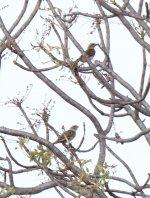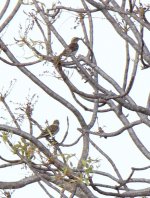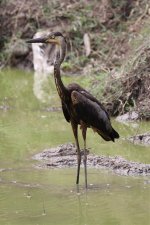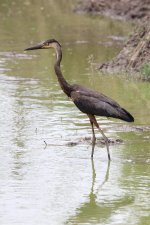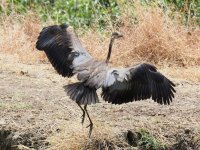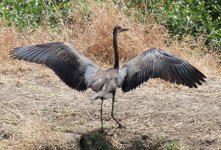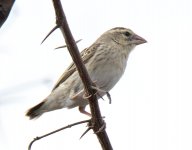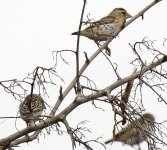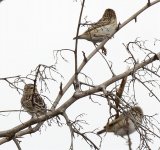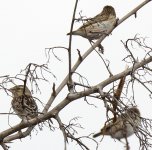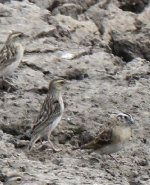-
Welcome to BirdForum, the internet's largest birding community with thousands of members from all over the world. The forums are dedicated to wild birds, birding, binoculars and equipment and all that goes with it.
Please register for an account to take part in the discussions in the forum, post your pictures in the gallery and more.
You are using an out of date browser. It may not display this or other websites correctly.
You should upgrade or use an alternative browser.
You should upgrade or use an alternative browser.
Tanzania birds to ID (1 Viewer)
- Thread starter andrewins
- Start date
More options
Who Replied?Hello Andrew, or André, whichever it is.
Since you went to the trouble of posting all those photos, it seems a pity that no-one has responded, and your thread is slipping down the rankings.
I'm a little surprised that none of the experts has replied, but I think the reason is obvious. You have posted far, far too many photos, and I suspect some people have thought each photo is of a different bird, scanned your posts and passed on. I really recommend that you post just one or two (the best) photos of each bird or situation, unless posting more really adds extra information. (Also remember some responders may be using up their phone data, or on the road in Africa with a low-speed wifi connection, so they can't look at that many photos.)
Anyway, to get things started, I'll take a stab at the posts you have labelled 'Cisticolas'.
I've been to Tanzania once, and to other places in East Africa and Southern Africa, but never to southern Tanzania.
Looking at Stevenson and Fanshawe, 'Birds of East Africa', it seems as though the cisticolas in Mikumi are restricted to Desert, Tiny, Croaking, Rattling, Winding and Trilling.
The bird you have numbered 3 has a very streaked head, and with other features (streaking, dark tail, etc) can only be Desert Cisticola, I think.
The bird you have numbered 2 seems to have a lighter colouration and a russety cap. I think this has to be Winding Cisticola, though we can't see the russet wing patch. In your bird 9, we can see the wing patch and so I think this should definitely be Winding.
Your bird 5 looks like a lark not a cisticola to me. It seems to have a crest, and otherwise the colours look good, so I think it's Rufous-naped Lark (the commonest in any case).
At first I thought your flock of little birds - your 4 - must be Red-billed Quelea juveniles or something. But none of them have a proper red bill, and in a couple of photos you see a bird with a black or brown and white streaked head pattern with a white crown stripe, and I think this must be the non-breeding male or female, so I maybe these are non-breeding or female or juvenile whydahs, but which species I can't guess. These little Whydahs, Widowbirds and Bishops, I forget what little I know about their non-male, non-breeding plumages in no time at all after getting back from a trip!
As well as the Bulbuls, I think there might be one or two other species in a couple of the photos, as there are a couple of birds that look similar but significantly larger that the main bird, and there is one that looks similar to the main bird but has a dark grey bill.
I think the Starling in 4 is OK for Greater Blue-eared, and I guess female Orange-winged Pytilia is all that fits bird 8, although the book seems to suggest it's out of range.
I wonder if your bird 6 is female Southern Red Bishop?
As for the flock in the trees, I'll leave it to others. I think there may be several species there. I wonder if one of the two birds you highlighted in your very last photo is Yellow-throated Petronia.
Anyway, that's the best I can do.
My answer will move your thread to the top. Hopefully, one of the experts will see it and answer.
The good news for you is that there are some experts who love to come and point out MacNara's mistakes on African birds. But it's fair enough, because most of what I do know, I learned from their answers to my questions in the first place. Smiley face.
Since you went to the trouble of posting all those photos, it seems a pity that no-one has responded, and your thread is slipping down the rankings.
I'm a little surprised that none of the experts has replied, but I think the reason is obvious. You have posted far, far too many photos, and I suspect some people have thought each photo is of a different bird, scanned your posts and passed on. I really recommend that you post just one or two (the best) photos of each bird or situation, unless posting more really adds extra information. (Also remember some responders may be using up their phone data, or on the road in Africa with a low-speed wifi connection, so they can't look at that many photos.)
Anyway, to get things started, I'll take a stab at the posts you have labelled 'Cisticolas'.
I've been to Tanzania once, and to other places in East Africa and Southern Africa, but never to southern Tanzania.
Looking at Stevenson and Fanshawe, 'Birds of East Africa', it seems as though the cisticolas in Mikumi are restricted to Desert, Tiny, Croaking, Rattling, Winding and Trilling.
The bird you have numbered 3 has a very streaked head, and with other features (streaking, dark tail, etc) can only be Desert Cisticola, I think.
The bird you have numbered 2 seems to have a lighter colouration and a russety cap. I think this has to be Winding Cisticola, though we can't see the russet wing patch. In your bird 9, we can see the wing patch and so I think this should definitely be Winding.
Your bird 5 looks like a lark not a cisticola to me. It seems to have a crest, and otherwise the colours look good, so I think it's Rufous-naped Lark (the commonest in any case).
At first I thought your flock of little birds - your 4 - must be Red-billed Quelea juveniles or something. But none of them have a proper red bill, and in a couple of photos you see a bird with a black or brown and white streaked head pattern with a white crown stripe, and I think this must be the non-breeding male or female, so I maybe these are non-breeding or female or juvenile whydahs, but which species I can't guess. These little Whydahs, Widowbirds and Bishops, I forget what little I know about their non-male, non-breeding plumages in no time at all after getting back from a trip!
As well as the Bulbuls, I think there might be one or two other species in a couple of the photos, as there are a couple of birds that look similar but significantly larger that the main bird, and there is one that looks similar to the main bird but has a dark grey bill.
I think the Starling in 4 is OK for Greater Blue-eared, and I guess female Orange-winged Pytilia is all that fits bird 8, although the book seems to suggest it's out of range.
I wonder if your bird 6 is female Southern Red Bishop?
As for the flock in the trees, I'll leave it to others. I think there may be several species there. I wonder if one of the two birds you highlighted in your very last photo is Yellow-throated Petronia.
Anyway, that's the best I can do.
My answer will move your thread to the top. Hopefully, one of the experts will see it and answer.
The good news for you is that there are some experts who love to come and point out MacNara's mistakes on African birds. But it's fair enough, because most of what I do know, I learned from their answers to my questions in the first place. Smiley face.
Last edited:
andrewins
Well-known member

Hello Andrew, or André, whichever it is.
Since you went to the trouble of posting all those photos, it seems a pity that no-one has responded, and your thread is slipping down the rankings.
I'm a little surprised that none of the experts has replied, but I think the reason is obvious. You have posted far, far too many photos, and I suspect some people have thought each photo is of a different bird, scanned your posts and passed on. I really recommend that you post just one or two (the best) photos of each bird or situation, unless posting more really adds extra information. (Also remember some responders may be using up their phone data, or on the road in Africa with a low-speed wifi connection, so they can't look at that many photos.)
Anyway, to get things started, I'll take a stab at the posts you have labelled 'Cisticolas'.
I've been to Tanzania once, and to other places in East Africa and Southern Africa, but never to southern Tanzania.
Looking at Stevenson and Fanshawe, 'Birds of East Africa', it seems as though the cisticolas in Mikumi are restricted to Desert, Tiny, Croaking, Rattling, Winding and Trilling.
The bird you have numbered 3 has a very streaked head, and with other features (streaking, dark tail, etc) can only be Desert Cisticola, I think.
The bird you have numbered 2 seems to have a lighter colouration and a russety cap. I think this has to be Winding Cisticola, though we can't see the russet wing patch. In your bird 9, we can see the wing patch and so I think this should definitely be Winding.
Your bird 5 looks like a lark not a cisticola to me. It seems to have a crest, and otherwise the colours look good, so I think it's Rufous-naped Lark (the commonest in any case).
At first I thought your flock of little birds - your 4 - must be Red-billed Quelea juveniles or something. But none of them have a proper red bill, and in a couple of photos you see a bird with a black or brown and white streaked head pattern with a white crown stripe, and I think this must be the non-breeding male or female, so I maybe these are non-breeding or female or juvenile whydahs, but which species I can't guess. These little Whydahs, Widowbirds and Bishops, I forget what little I know about their non-male, non-breeding plumages in no time at all after getting back from a trip!
As well as the Bulbuls, I think there might be one or two other species in a couple of the photos, as there are a couple of birds that look similar but significantly larger that the main bird, and there is one that looks similar to the main bird but has a dark grey bill.
I think the Starling in 4 is OK for Greater Blue-eared, and I guess female Orange-winged Pytilia is all that fits bird 8, although the book seems to suggest it's out of range.
I wonder if your bird 6 is female Southern Red Bishop?
As for the flock in the trees, I'll leave it to others. I think there may be several species there. I wonder if one of the two birds you highlighted in your very last photo is Yellow-throated Petronia.
Anyway, that's the best I can do.
My answer will move your thread to the top. Hopefully, one of the experts will see it and answer.
The good news for you is that there are some experts who love to come and point out MacNara's mistakes on African birds. But it's fair enough, because most of what I do know, I learned from their answers to my questions in the first place. Smiley face.
Hello, MacNara.
Thank you very much for your ID and advices! Now I have 3 more lifers after your ID suggestion!
Next time I'll try to post less number of pics. The reason for the big quantity of them was that I thought that more pics could be more helpful for ID.
Now I'm adding just few pics of one strange heron from Mikumi NP. The date is the same - 12.10.2018. One guy supposed it was a Madagascar heron but I think it is a melanistic Grey heron or a bit strange Purple heron.
Attachments
Last edited:
Larry Sweetland
Formerly 'Larry Wheatland'
I think it's a soiled Grey Heron
I think it's a soiled Grey Heron
Yes, I think so, too. But if the local guide thought otherwise, it made me try to imagine what else it could be. And it does at the same time have black parts which are heavily marked, especially the throat, but also reddish tones in some places.
Grey Herons breed very near my house in central Japan, so in Africa, I tend to only glance at them, so I probably miss localised plumage differences.
More importantly, althought there are zillions of photos, there are only seven or eight individual birds in the thread, and I doubt if all my IDs are correct, let alone the final few photos of a flock in a tree, so if you or any other experts would comment on those it would be great.
Larry Sweetland
Formerly 'Larry Wheatland'
In terms of jizz it looks too slender to be a Grey Heron and I would favour soiled or partially melanistic Purple Heron.
The poor thing's a total mess. I see a bird with the jizz and plumage of a Grey Heron in an oil slick. To me the bill shape looks better for Grey than for either Purple or Black-headed. Also it has unmarked pale ear coverts (dark in Black-headed, dark line in Purple). Can't see a reason to look for a melanistic bird here.
Mac, I've had a quick scroll down this thread and all I can say is fair play for giving the rest of it a go! :t: I've not been to that NP, and the pics are like a "best of BF Id forum's African nightmare golden greats" album![/CODE]. Good luck!
Larry Sweetland
Formerly 'Larry Wheatland'
..I'd personally be a bit wary of a couple of the id's mentioned so far. The pytilia pic isn't the clearest, and in a search I quickly found a Green-winged where the colour of the flight feathers was pretty similar to the OP bird. In pics it seems to vary with angle and light......(as does iris colour in weavers, so I wouldn't be so sure about Lesser Masked for #1....)
If Orange-winged P isn't supposed to be at the site, I'd not charge in with the indelible ink quite yet!.
If Orange-winged P isn't supposed to be at the site, I'd not charge in with the indelible ink quite yet!.
andrewins
Well-known member

Hello, MacNara, Larry and Foxy! Thank you for your replies and ID suggetions!
As for the Heron I'm thinking about Grey too because of the shape of the head cap. Its shape is exactly the same as only Grey has. But I never saw oiled birds. Also the bird was not tired or exhausted. It has a normal behaviour of a healthy bird. That is why I thought it is melanistic.
As for the pics quality I apologies for that but these are the only that are left unidentified from that trip. I've made hundred thousands of shots during this trip as do most of us . And most of the birds on good pics are identified already. Only hard birds and worse pics are left to ID. I always try to ID everything because there can be a lifer hidden in any of those pics
. And most of the birds on good pics are identified already. Only hard birds and worse pics are left to ID. I always try to ID everything because there can be a lifer hidden in any of those pics  So I'm very thankful for your ID suggestions and if you could add something more to the ID suggestions that would be just great!
So I'm very thankful for your ID suggestions and if you could add something more to the ID suggestions that would be just great!
As for the Heron I'm thinking about Grey too because of the shape of the head cap. Its shape is exactly the same as only Grey has. But I never saw oiled birds. Also the bird was not tired or exhausted. It has a normal behaviour of a healthy bird. That is why I thought it is melanistic.
As for the pics quality I apologies for that but these are the only that are left unidentified from that trip. I've made hundred thousands of shots during this trip as do most of us
Hi Andrew. I did my best from my experience and from the books and also tried to give reasons for the IDs I made, so you can judge for yourself whether these reasons make sense or not. For example, I looked at the distribution maps for Tanzania in Stevenson and Fanshawe and I therefore think the cisticola and lark IDs are OK because there are no alternatives that look roughly the same.
By the way, apart from the Pytilia, I don't think Larry was complaining about the photo quality, just that you have a selection of birds (cisticolas and whydahs/indigobirds, etc) which are famously difficult to identify. I lightened the Pytilia on my screen, to check the colours, and I couldn't find anything that fitted better than a female, for example.
There are a couple of African super-experts and a couple of very-experts who have been on the forum in the last week, but they have not come onto this thread. I don't know why. There are also a number of people who are experts, but specialise in certain groups, e.g. raptors. I've learned most of what I know about 'difficult' cases from submitting my own photos and getting replies from these people, so by doing my best to answer and bumping the thread to the top, I was hoping that one or more of these people would look in and give more definitive opinions that I am able to do.
Anyway, to repeat, I tried to give reasons, so you can judge for yourself.
Regards, MacNara
By the way, apart from the Pytilia, I don't think Larry was complaining about the photo quality, just that you have a selection of birds (cisticolas and whydahs/indigobirds, etc) which are famously difficult to identify. I lightened the Pytilia on my screen, to check the colours, and I couldn't find anything that fitted better than a female, for example.
There are a couple of African super-experts and a couple of very-experts who have been on the forum in the last week, but they have not come onto this thread. I don't know why. There are also a number of people who are experts, but specialise in certain groups, e.g. raptors. I've learned most of what I know about 'difficult' cases from submitting my own photos and getting replies from these people, so by doing my best to answer and bumping the thread to the top, I was hoping that one or more of these people would look in and give more definitive opinions that I am able to do.
Anyway, to repeat, I tried to give reasons, so you can judge for yourself.
Regards, MacNara
andrewins
Well-known member

Hi Andrew. I did my best from my experience and from the books and also tried to give reasons for the IDs I made, so you can judge for yourself whether these reasons make sense or not. For example, I looked at the distribution maps for Tanzania in Stevenson and Fanshawe and I therefore think the cisticola and lark IDs are OK because there are no alternatives that look roughly the same.
By the way, apart from the Pytilia, I don't think Larry was complaining about the photo quality, just that you have a selection of birds (cisticolas and whydahs/indigobirds, etc) which are famously difficult to identify. I lightened the Pytilia on my screen, to check the colours, and I couldn't find anything that fitted better than a female, for example.
There are a couple of African super-experts and a couple of very-experts who have been on the forum in the last week, but they have not come onto this thread. I don't know why. There are also a number of people who are experts, but specialise in certain groups, e.g. raptors. I've learned most of what I know about 'difficult' cases from submitting my own photos and getting replies from these people, so by doing my best to answer and bumping the thread to the top, I was hoping that one or more of these people would look in and give more definitive opinions that I am able to do.
Anyway, to repeat, I tried to give reasons, so you can judge for yourself.
Regards, MacNara
Hi MacNara,
Thank you very much for support! I've immediadely edited my eBird checklists accourding to your ID after your first reply (exept the heron - it is still not included in the checklist from Mikumi - waiting for answers from few birders).
Larry Sweetland
Formerly 'Larry Wheatland'
, I don't think Larry was complaining about the photo quality, just that you have a selection of birds (cisticolas and whydahs/indigobirds, etc) which are famously difficult to identify.
Absoloutely! At least you didn't hit us with any pipits, but cisticolas, euplectes spp, glossy starlings and female-plumaged weavers are a total nightmare for prett much anyone. They tend to make larks look easy!
andrewins
Well-known member

Absoloutely! At least you didn't hit us with any pipits, but cisticolas, euplectes spp, glossy starlings and female-plumaged weavers are a total nightmare for prett much anyone. They tend to make larks look easy!
There were no pipits unfortunately
andrewins
Well-known member

Because of the location, the pinkish bill, and the fact that non-breeding males, females, and juveniles are said to be indistinguishable, I think these are probably Southern Red Bishop.
See here for a comparison.
But maybe Black-winged Red Bishop is a possibility?
I think it has to be some Euplectes species.
See here for a comparison.
But maybe Black-winged Red Bishop is a possibility?
I think it has to be some Euplectes species.
And going back to your series of photos numbered #4, I guess these would mostly be the same - i.e. Southern Red Bishop, non-breeding season. But there are also a few other birds, which I think are Vidua, such as the attached (the bird on the right) which I cropped from one of your #4 photos. I now think that the very common bird in #4 (on the left in my crop) is not the same as this Vidua (whereas before I thought that these more-like-breeding-plumage birds gave a clue to the ID of the common species).
I really hoped that one of the real experts would look at this thread for a few seconds, because the photos are mostly quite clear, so they would be able to confirm or correct IDs in no time.
I really hoped that one of the real experts would look at this thread for a few seconds, because the photos are mostly quite clear, so they would be able to confirm or correct IDs in no time.
Attachments
Larry Sweetland
Formerly 'Larry Wheatland'
And going back to your series of photos numbered #4, I guess these would mostly be the same - i.e. Southern Red Bishop, non-breeding season. But there are also a few other birds, which I think are Vidua, such as the attached (the bird on the right) which I cropped from one of your #4 photos. I now think that the very common bird in #4 (on the left in my crop) is not the same as this Vidua (whereas before I thought that these more-like-breeding-plumage birds gave a clue to the ID of the common species).
I really hoped that one of the real experts would look at this thread for a few seconds, because the photos are mostly quite clear, so they would be able to confirm or correct IDs in no time.
I was also assuming Southern Red Bishop was the likely option for at least most of the euplectes(-looking!) birds. And as fror the whyda, no books here, but suspect the combo of dark bill and peachy breast might narrow it down.
andrewins
Well-known member

Because of the location, the pinkish bill, and the fact that non-breeding males, females, and juveniles are said to be indistinguishable, I think these are probably Southern Red Bishop.
See here for a comparison.
But maybe Black-winged Red Bishop is a possibility?
I think it has to be some Euplectes species.
Thank you very much for fast reply! I think that can be Southern Red Bishop. Black-winged Red Bishop accoarding to eGuide to Birds of East Africa by Stevenson and Fanshawe have more dark breast.
andrewins
Well-known member

And going back to your series of photos numbered #4, I guess these would mostly be the same - i.e. Southern Red Bishop, non-breeding season. But there are also a few other birds, which I think are Vidua, such as the attached (the bird on the right) which I cropped from one of your #4 photos. I now think that the very common bird in #4 (on the left in my crop) is not the same as this Vidua (whereas before I thought that these more-like-breeding-plumage birds gave a clue to the ID of the common species).
I really hoped that one of the real experts would look at this thread for a few seconds, because the photos are mostly quite clear, so they would be able to confirm or correct IDs in no time.
Thank you very much for the crop and suggestion! I think it can be Eastern Paradise Whydah.
Users who are viewing this thread
Total: 2 (members: 0, guests: 2)




